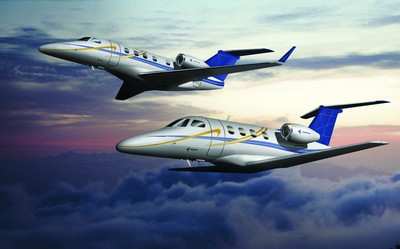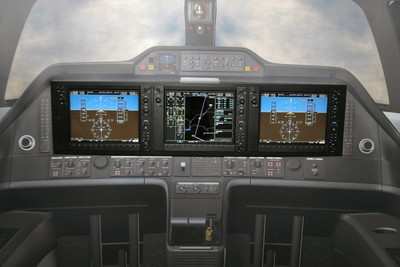Garmin has announced that Embraer has selected the Garmin G1000
integrated avionics suite as the avionics package for Embraer's new
Very Light Jet and Light Jet business aircraft.
"Embraer is an established and respected leader in aviation, and
we are very pleased to have been selected as the avionics
supplier," said Gary Kelley, Garmin's vice president,
marketing. "This announcement further validates the G1000's
flexibility as the industry's leading avionics suite for a wide
range of aircraft."
"Embraer is committed to delivering truly revolutionary products
to our sophisticated customer base. Garmin has the most
integrated system on the market for this class and will bring
intuitive cutting-edge technology to the cockpit," said Lu�s
Carlos Affonso, Embraer Senior Vice President, Executive Aviation.
"Embraer's tailored solution, to be called Prodigy, will offer new
levels of integration, display flexibility, and monitoring of
aircraft systems."

Garmin's all-glass, fully-integrated avionics suite offers
Embraer's Very Light Jet and Light Jet operators more advantages
than any other avionics suite in today's market. The
pilot-friendly cockpit features three 12-inch displays - two
primary flight displays (PFD) and one multi-function display (MFD).
The system integrates all primary flight, navigation,
communication, terrain, traffic, weather, engine instrumentation,
and crew-alerting system data and presents the composite
information in brilliant, sunlight-readable color on
high-definition displays.

- The 12-inch PFDs and MFD present traditional cockpit
information in an integrated fashion on a large-format display, and
puts all aircraft-systems monitoring, situational awareness, and
flight-planning functions at the pilot's fingertips
- Garmin's revolutionary new GFC 700 three axis, fully digital,
dual channel, fail passive Automatic Flight Control System (AFCS).
The GFC 700 features roll, pitch and yaw control, with automatic
Pitch Trim and Mach Trim control, and additional features not found
in other autopilots
- A panel-mounted, alpha-numeric keypad will allow pilots to
complete FMS, navigation, and communication functions from the
keypad, in addition to using controls located around the PFD and
MFD. The keypad's ergonomic and straight-forward design
decreases pilot workload by offering a faster way to enter FMS data
and manage the G1000's integrated communication and
navigation.
- Dual integrated solid-state Attitude and Heading Reference
Systems (AHRS), which can align while in motion, including
in-flight dynamic restarts
- Dual integrated RVSM-Compliant Digital Air Data Computers
(DADC's)
Integrated Engine Indication and Crew Alerting System (EICAS) with
full screen synoptics and Centralized Maintenance Computer (CMC)
like functionality
Integrated Mode S transponder with Traffic Information Service,
which meets European requirements for Elementary and Enhanced
Surveillance
-
 Dual integrated radio modules that
provide oceanic, enroute, terminal, and approach-approved FMS
navigation with GPS/WAAS; VHF navigation with ILS; and VHF
communication with 16-watt transceivers and 8.33-kHz channel
spacing
Dual integrated radio modules that
provide oceanic, enroute, terminal, and approach-approved FMS
navigation with GPS/WAAS; VHF navigation with ILS; and VHF
communication with 16-watt transceivers and 8.33-kHz channel
spacing
Integrated Class-B Terrain Awareness and Warning System (TAWS) with
worldwide terrain and obstacle database, which does not require an
external LRU as with other TAWS systems
- Integrated satellite weather datalink and digital-quality audio
via XM Satellite Radio
- Dual integrated digital audio control systems
- Integrated design with reversionary capabilities, allowing all
flight-critical data to transfer seamlessly to a single display for
added safety during flight
- Fully digital Airborne Weather RADAR with Horizontal and
Vertical scanning capability
Introduced in May 2005, Embraer's Very Light Jet and Light Jet
expand Embraer's business aviation product line. The Very Light Jet
will accommodate up to eight people, will be certified to operate
at 41,000 feet at Mach 0.70 (380 KTAS), and is expected to enter
service in mid-2008. The Light Jet is designed to carry up to nine
people, will be certified to operate at 45,000 feet at Mach 0.78
(450 KTAS), and is expected to enter service in mid-2009.
 ANN's Daily Aero-Linx (05.06.25)
ANN's Daily Aero-Linx (05.06.25) ANN's Daily Aero-Term (05.06.25): Ultrahigh Frequency (UHF)
ANN's Daily Aero-Term (05.06.25): Ultrahigh Frequency (UHF) ANN FAQ: Q&A 101
ANN FAQ: Q&A 101 Classic Aero-TV: Virtual Reality Painting--PPG Leverages Technology for Training
Classic Aero-TV: Virtual Reality Painting--PPG Leverages Technology for Training Airborne 05.02.25: Joby Crewed Milestone, Diamond Club, Canadian Pilot Insurance
Airborne 05.02.25: Joby Crewed Milestone, Diamond Club, Canadian Pilot Insurance




